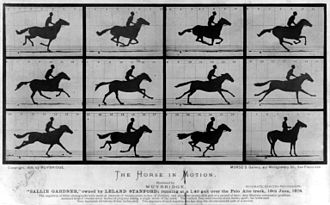Horse in Motion
It may come as a surprise in the twenty-first century to discover that, in the 1880s, details of how objects move were unknown. The human eye, unaided, cannot resolve the details of fast motion. Eadweard Muybridge and his experiments with motion photography, such as this series of pictures of a horse's gait, helped solve this mystery.
A galloping horse
His most famous work began in 1872, when he was hired by Leland Stanford (later the founder of Stanford University) to photograph horses. Stanford reputedly had made a bet that for a moment, all four of a racehorse's hooves are off the ground simultaneously, and he hired Muybridge to take the pictures to prove him right. This was difficult to do with the cameras of the time, and the initial experiments produced only indistinct images. The photographer then became distracted when he discovered that his young wife had taken a lover and may even have had their child by him. Muybridge tracked down the lover and shot and killed him. When Muybridge stood trial, he did not deny the killing, but he was nonetheless acquitted.
 Muybridge left San Francisco and spent two years in Guatemala. On his return, Muybridge resumed his photography of horses in motion, this time far more successfully. … The results settled the debate once and for all: all four hooves do leave the ground at once, as the top middle image in this sequence demonstrates.
Muybridge left San Francisco and spent two years in Guatemala. On his return, Muybridge resumed his photography of horses in motion, this time far more successfully. … The results settled the debate once and for all: all four hooves do leave the ground at once, as the top middle image in this sequence demonstrates.
From http://www.hrc.utexas.edu/exhibitions/permanent/windows/southeast/eadweard_muybridge.html - edited and shortened

